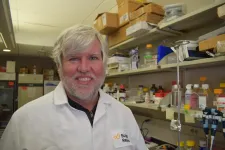(Press-News.org) Many surgeries today are performed via minimally invasive procedures, in which a small incision is made and miniature cameras and surgical tools are threaded through the body to remove tumors and repair damaged tissues and organs. The process results in less pain and shorter recovery times compared to open surgery.
While many procedures can be performed in this way, surgeons can face challenges at an important step in the process: the sealing of internal wounds and tears.
Taking inspiration from origami, MIT engineers have now designed a medical patch that can be folded around minimally invasive surgical tools and delivered through airways, intestines, and other narrow spaces, to patch up internal injuries. The patch resembles a foldable, paper-like film when dry. Once it makes contact with wet tissues or organs, it transforms into a stretchy gel, similar to a contact lens, and can stick to an injured site.
In contrast to existing surgical adhesives, the team's new tape is designed to resist contamination when exposed to bacteria and bodily fluids. Over time, the patch can safely biodegrade away. The team has published its results in the journal Advanced Materials.
The researchers are working with clinicians and surgeons to optimize the design for surgical use, and they envision that the new bioadhesive could be delivered via minimally invasive surgical tools, operated by a surgeon either directly or remotely via a medical robot.
"Minimally invasive surgery and robotic surgery are being increasingly adopted, as they decrease trauma and hasten recovery related to open surgery. However, the sealing of internal wounds is challenging in these surgeries," says Xuanhe Zhao, professor of mechanical engineering and of civil and environmental engineering at MIT.
"This patch technology spans many fields," adds co-author Christoph Nabzdyk, a cardiac anesthesiologist and critical care physician at the Mayo Clinic in Rochester, Minnesota. "This could be used to repair a perforation from a coloscopy, or seal solid organs or blood vessels after a trauma or elective surgical intervention. Instead of having to carry out a full open surgical approach, one could go from the inside to deliver a patch to seal a wound at least temporarily and maybe even long-term."
The study's co-authors include lead authors Sarah Wu and Hyunwoo Yuk, and Jingjing Wu at MIT.
Layered protection
The bioadhesives currently used in minimally invasive surgeries are available mostly as biodegradable liquids and glues that can be spread over damaged tissues. When these glues solidify, however, they can stiffen over the softer underlying surface, creating an imperfect seal. Blood and other biological fluids can also contaminate glues, preventing successful adhesion to the injured site. Glues can also wash away before an injury has fully healed, and, after application, they can also cause inflammation and scar tissue formation.
Given the limitations of current designs, the team aimed to engineer an alternative that would meet three functional requirements. It should be able to stick to the wet surface of an injured site, avoid binding to anything before reaching its destination, and once applied to an injured site resist bacterial contamination and excessive inflammation.
The team's design meets all three requirements, in the form of a three-layered patch. The middle layer is the main bioadhesive, made from a hydrogel material that is embedded with compounds called NHS esters. When in contact with a wet surface, the adhesive absorbs any surrounding water and becomes pliable and stretchy, molding to a tissue's contours. Simultaneously, the esters in the adhesive form strong covalent bonds with compounds on the tissue surface, creating a tight seal between the two materials. The design of this middle layer is based on previous work in Zhao's group.
The team then sandwiched the adhesive with two layers, each with a different protective effect. The bottom layer is made from a material coated with silicone oil, which acts to temporarily lubricate the adhesive, preventing it from sticking to other surfaces as it travels through the body. When the adhesive reaches its destination and is pressed lightly against an injured tissue, the silicone oil is squeezed out, allowing the adhesive to bind to the tissue.
The adhesive's top layer consists of an elastomer film embedded with zwitterionic polymers, or molecular chains made from both positive and negative ions that act to attract any surrounding water molecules to the elastomer's surface. In this way, the adhesive's outward-facing layer forms a water-based skin, or barrier against bacteria and other contaminants.
"In minimally invasive surgery, you don't have the luxury of easily accessing a site to apply an adhesive," Yuk says. "You really are battling a lot of random contaminants and body fluids on your way to your destination."
Fit for robots
In a series of demonstrations, the researchers showed that the new bioadhesive strongly adheres to animal tissue samples, even after being submerged in beakers of fluid, including blood, for long periods of time.
They also used origami-inspired techniques to fold the adhesive around instruments commonly used in minimally invasive surgeries, such as a balloon catheter and a surgical stapler. They threaded these tools through animal models of major airways and vessels, including the trachea, esophagus, aorta, and intestines. By inflating the balloon catheter or applying light pressure to the stapler, they were able to stick the patch onto torn tissues and organs, and found no signs of contamination on or near the patched-up site up to one month after its application.
The researchers envision that the new bioadhesive could be manufactured in prefolded configurations that surgeons can easily fit around minimally invasive instruments as well as on tools that are currently being used in robotic surgery. They are seeking to collaborate with designers to integrate the bioadhesive into robotic surgery platforms.
"We believe that the conceptual novelty in the form and function of this patch represents an exciting step toward overcoming translational barriers in robotic surgery and facilitating the wider clinical adoption of bioadhesive materials," Wu says.
INFORMATION:
This research was supported, in part, by the National Science Foundation.
Written by Jennifer Chu, MIT News Office
Additional background
Paper: "Multifunctional Origami Patch for Minimally Invasive Tissue Sealing"
https://onlinelibrary.wiley.com/doi/10.1002/adma.202007667
Interim analysis from phase 3 trial of nearly 20,000 participants suggests efficacy of two-dose regimen of the adenovirus-based vaccine is 91.6% against symptomatic COVID-19 - trial reports 16 COVID-19 cases in the vaccine group (0.1% [16/14,964) and 62 cases (1.3% [62/4,902]) in the placebo group.
No serious adverse events were deemed to be associated with vaccination, and most reported adverse events were mild, including flu-like symptoms, pain at injection site and weakness or low energy.
Sub-analysis of 2,000 adults older than 60 years suggests the vaccine is similarly effective and well tolerated in this group.
Trial is ongoing ...
JUPITER, FL - A collaboration led by Scripps Research has developed a way to separate the beneficial anti-inflammatory properties of a group of steroids called glucocorticoids from some of their unwanted side-effects, through an optimization process they named "ligand class analysis."
Their process enabled them to engineer two new, drug-like compounds that show steroidal anti-inflammatory action and other specific traits. One boosts muscle and energy supply, while the other reduces risk of muscle-wasting and bone loss typical of such drugs.
Their report, titled, "Chemical systems biology ...
TAMPA, Fla. -- Chimeric antigen receptor T-cell therapy, or CAR T, has been a breakthrough in the treatment of blood cancers such as acute lymphoblastic leukemia and diffuse large B-cell lymphoma. Clinical studies have shown overall response rates of more than 80% with an ongoing response of nearly 40% more than two years after therapy. However, the cellular immunotherapy doesn't work for every patient. Moffitt Cancer Center, one of the leading centers for cellular immunotherapy, is researching why some patients have a better CAR T response than others and what can be done to improve the treatment's effectiveness. In a new study ...
The many different sensations our bodies experience are accompanied by deeply complex exchanges of information within the brain, and the feeling of pain is no exception. So far, research has shown how pain intensity can be directly related to specific patterns of oscillation in brain activity, which are altered by the activation and deactivation of the 'interneurons' connecting different regions of the brain. However, it remains unclear how the process is affected by 'inhibitory' interneurons, which prevent chemical messages from passing between these regions. Through new research published in EPJ ...
Researchers developing renewable plastics and exploring new processes for plastics upcycling and recycling technologies will now be able to easily baseline their efforts to current manufacturing practices to understand if their efforts will save energy and reduce greenhouse gas emissions.
Benchmark data calculated and compiled at the National Renewable Energy Laboratory (NREL) provide a measurement--at the supply chain level--of how much energy is required and the amount of greenhouse gases emitted from the production of a variety of plastics in the United States.
"Today, we employ a predominantly linear economy for many of the materials we use, including plastics," said Gregg Beckham, a senior research fellow at NREL. "Many people ...
A soft, flexible sensor system created with electrically conductive yarns could help map problematic pressure points in the socket of an amputee's prosthetic limb, researchers from North Carolina State University report in a new study.
In IEEE Sensors Journal, researchers from North Carolina State University reported on the lightweight, soft textile-based sensor prototype patch. The device incorporates a lattice of conductive yarns and is connected to a tiny computer. They tested the system on a prosthetic limb and in walking experiments with two human volunteers, finding the system could ...
An international research team from the Photobiotechnology Research Group at Ruhr-Universität Bochum (RUB) led by Professor Thomas Happe and the Laboratoire de Bioénergétique et Ingénierie des Protéines (CNRS) in Marseille has been able to get to the bottom of this unique feature. They describe the molecular mechanism in Nature Communications on 2 February 2021.
Enzyme repeatedly survives the attack unharmed
Representatives of the [FeFe]-hydrogenase enzyme group combine protons and electrons to form molecular hydrogen at particularly high turnover rates. Some of them even use sunlight as a primary energy source ...
DANVILLE, Pa. and GAITHERSBURG, Md. - Researchers have discovered a strong link between genetic changes known to cause neurodevelopmental disabilities and cerebral palsy.
Cerebral palsy affects movement and posture and often co-occurs with other neurodevelopmental disorders, including intellectual disability, epilepsy and autism spectrum disorder. Individual cases of cerebral palsy are often attributed to birth asphyxia, although recent studies indicate that asphyxia accounts for less than 10% of cases. A growing body of research indicates that cerebral palsy may be caused by genetic changes, ...
BOSTON -- Genome-wide association studies (GWAS) have typically excluded diverse and minority individuals in the search for gene variants that confer risk of disease. Researchers at Massachusetts General Hospital (MGH), the Broad Institute of MIT and Harvard, and other institutions around the world have now developed a free-access software package called Tractor that increases the discovery power of genomics in understudied populations. A study of Tractor's performance and accuracy was published in END ...
New research has found that men who have the Western world's most common genetic disorder are more likely to develop dementia, compared to those without the faulty genes.
Researchers at the University of Exeter and the University of Connecticut have previously found that men with two faulty genes that cause the iron overload condition haemochromatosis are more likely to develop liver cancer, arthritis and frailty, compared to those without the faulty genes.
Now, the team's new analysis of more than 335,000 people of European ancestry in UK Biobank, ...

